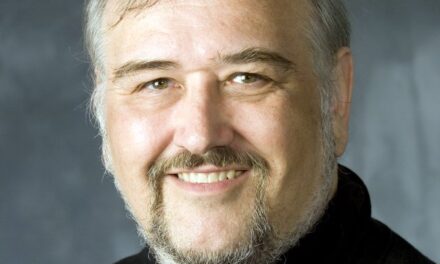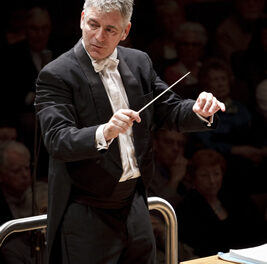Two years ago, Ara Gregorian, artistic director of the Four Seasons Chamber Music Festival, paired two substantial piano quintets by Shostakovich and Dvořák in the third concert of the 2006-07 season, and the contrast was striking. For the finale of the 2008-09 Season, played in Fletcher Recital Hall at East Carolina University, Gregorian paired the same Dvořák quintet with a quintet by Ernest Bloch, and the contrast was just as striking.
Bloch’s Piano Quintet No. 1 (1921-23) is not nearly as abstract as, say, the Elliott Carter string quartet that was part of the NewMusic@ECU Festival in late March. But the quintet is not automatically enjoyable, either — there are no grand or sweeping melody lines, for instance. This composition requires considerable skills from all the players as it demands the listener’s attention and even concentration.
The work starts out with an appropriately named agitato movement and stays fairly agitated throughout, not to mention dark, brooding, dense, and intense. The piece features frequent unison passages that add to the dense intensity, yet it never moves into the realm of inaccessibility. A sense of nervous urgency, with surging piano phrases played briefly over the four string parts, marks this movement. After a march-like cadence, the sound softens, if only momentarily, before picking up in stridency again.
The first movement, in fact, sounds as if it could accompany the most suspenseful part of a Hitchcock thriller, with some strange scoring for strings that “sag” from sharp to natural or from natural to flat. Pianist Thomas Sauer propelled most of the movement, although each string player (Soovin Kim on first violin, Elina Vähälä on second violin, Gregorian on viola, and Amit Peled on cello) contributed a distinctive voice to the playing.
The second movement, marked “Andante mistico,” continues the brooding feeling of the first movement in a minor key but without the agitation. The piano line is a near-incessant series of rhythmically-played chords, mainly in the right hand, and a few more sagging string notes can be heard. The movement ascends in intensity to a cluster of high notes played in unison nicely by Kim and Vähälä, with Peled playing an octave lower.
The concluding movement (Allegro energico) returns to the sound of the opening, with occasional unison string playing, emphatic piano lines and more nervous energy. Whereas the opening movement could remind someone of the musical accompaniment for a suspenseful movie, this movement, at times, sounds as if it could accompany a swirl of traffic in Times Square, or perhaps some kind of chase scene.
Sauer added considerable weight and density to the movement with a powerful left-handed tremolo, but the ending catches the listener by complete surprise — it is an exquisitely graceful four minutes of melancholy, with the piano line rising up the scale, and the violins and viola playing in high-pitched unison over a steady cello. If Stravinsky had applied the ending of Firebird to Rite of Spring, you would have something similar to the ending of Bloch’s quintet.
Thirty-five years earlier, Antonín Dvořák completed his Piano Quintet No. 2 in A, Op. 81, a near-perfect piece of chamber music that reflects both his mastery of orchestral scoring and his familiarity with the more intimate aspects of small ensemble composition. From the opening singing line in the cello to the rousing closing, the quintet never fails to satisfy. At times, the listener is drawn to the lovely piano lines, which Sauer executed so well, and at other times, the string ensemble playing stands out. The quartet for this performance (with Vähälä playing first violin and Kim playing second) was outstanding, even thrilling.
The contrasts in intensity and tempi in the opening movement — Allegro, ma non tanto — offered opportunities for the players to shine individually and in smaller ensembles. The initial somber theme played by the cello, for instance, reappears later in the movement in the violins and viola, and a lovely first violin solo by Vähälä was repeated by Gregorian, and then later echoed by Vähälä playing over nice pizzicato in Peled’s cello.
The familiar opening statement of the andante con moto (said to be the basis for the popular song “Nature Boy”), reappears several times throughout the movement, mainly in the piano, although Gregorian and Peled also add their own luster to restatements of the theme and in other separate passages.
The lively third movement, “Scherzo, molto vivace,” an energetic dance that swirls about in the playing by all five performers, is full of excitement but is all too brief. Similar energy is shown at the beginning of the fourth movement (Allegro), with especially busy piano lines and a brief fugue-like passage that engages all players. An interesting thing happens two-thirds of the way through the movement, however, when the energy level slows down considerably, causing the listener to think that a section of introspective or contemplative music will follow. The change in mood is only momentary, however, and the pace quickens to a thrilling conclusion.
Another season of masterful music-making is in the books, and again, Gregorian has provided his audiences with some lasting memories of top-level performances. The 2009-10 Season will mark the festival’s 10th anniversary, and the eastern Carolina region is much the better place for having this program as a musical resource.













